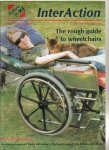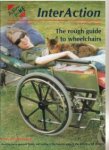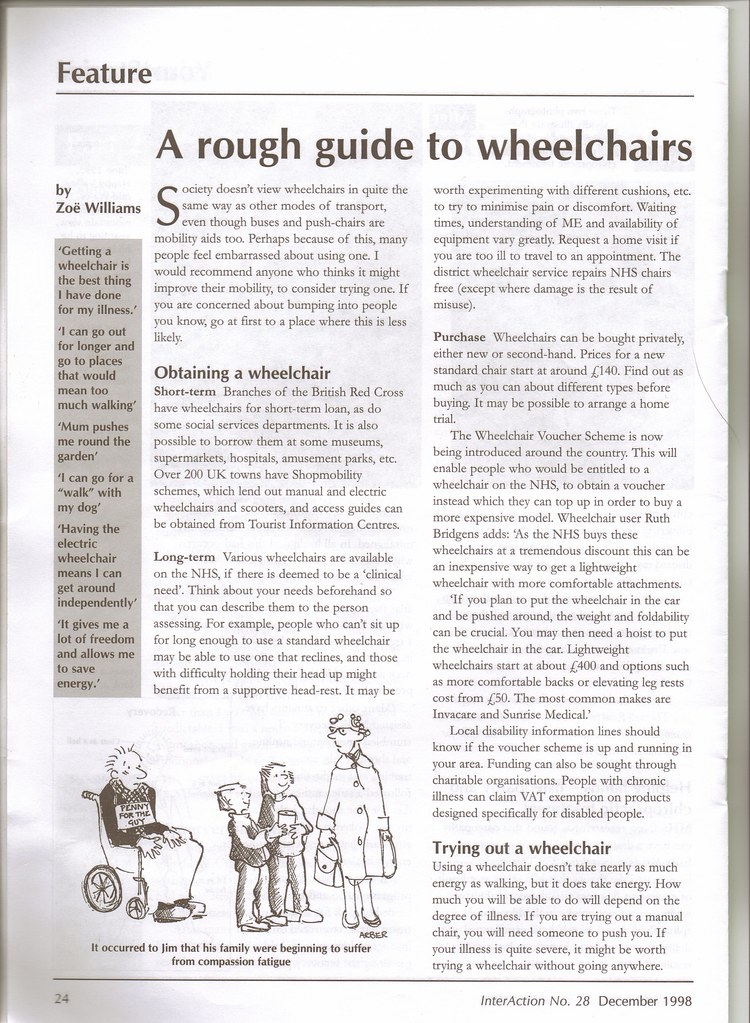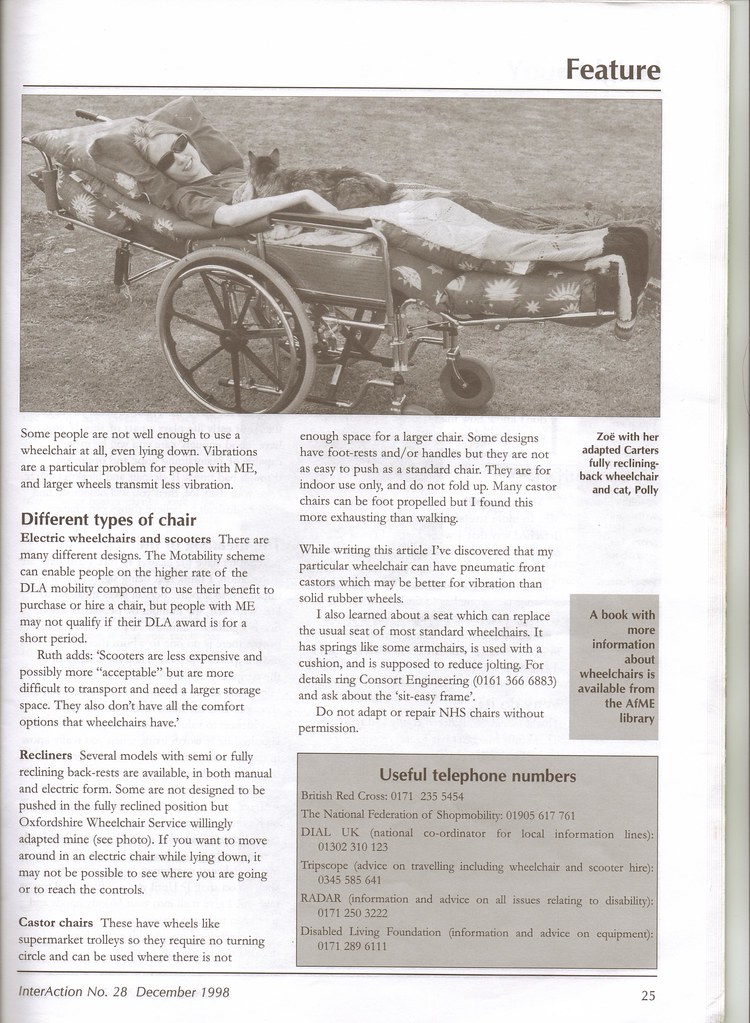Hi all, I have been meaning to start a thread on this topic for a while. I have been using a wheelchair and mobility scooter for about 7 years now. I have picked up a few tips and that along the way so I thought it would be useful to pass these on. I'll start with Reclining manual wheelchairs as I just spoke to a mother of someone who uses one so have the information fresh in my head (and also written on the back of an envelope which I am sure to lose, so better write it down here quick!).
Reclining Manual Wheelchairs
I first saw a picure of a reclining wheelchair on the front page of Interaction, the magazine of the UK group. I have scanned it in and hope it comes out below. You might have to click on the attachment.
Basically with a Recline wheelchair you can incline the backrest in increments so that it is tilted a little, or a lot, so that you don't have to be fully upright. You can also tilt it so far back that it is flat and like a bed. This could be useful for someone who has very bad dizziness or orthostatic intolerance and who cannot sit up for much time without feeling terrible, but who either has to go to an appointment, or wants to move from the bed (e.g. to lie outside for a bit on a nice day).
It could also be useful occassionally for a less severe person who had to, or wanted to, do something that was going to involve being out of the house for a few hours, and where they might need to lie down for a bit for a rest.
A very severe, bedbound, friend of mine got one when she needed to go to the hospital for an appointment. They had found in the past that you can run into problems when you ask if you can lie down. Without knowing the history nurses etc. can think you are just being a Prima Donna. Also sometimes you can be at an appointment somewhere where a bed is not readily available because all of them are occupied, or they don't have beds anywhere hear where the appointment is. It is easier to have your own "bed" as it saves energy explaining, trying to organise something difficult, or banging your head off a brick wall if you come up against someone particularly ignorant.
They told me their one folds in the middle like an ordinary wheelchair would. There is a head rest that can come off. And the foot rests also come off. This would make it easier to get into a car. They have a hatch-back so unfortunately I don't know about what it would be like in an ordinary car. It might fit into a larger boot/trunk.
It is a bit heavier than an ordinary manual chair. Her husband could lift it out on his own but you might need 2 if the people aren't particularly strong. She said she could manage getting an ordinary manual wheelchair out of the car but would need help with this one.
As with any manual chair for an ME/CFS person you would need someone to push you. Remember it is not just a walking/balance/standing problem people can have, but also exercise intolerance in general, so this affects the arms and shoulders also. Trying to self-propel, other than short distances on the flat, is probably out of the question for the majority of people with ME/CFS who would be sick enough to be using a wheelchair.
The brand of the recline wheelchair they got was Days Healthcare. It seems to be one of these ones on the top of the page http://tinyurl.com/ylze993
Note, there are 2 different chair widths. You would need to check if buying or renting a chair like this (or any other wheelchair) that you were getting a size that suited you. Remember with the reclines especially you have to take into account your shoulder width as well as the width needed for the seat to sit on.
She thinks they paid 275 Euro for it in Dublin, Ireland (this seems like exceptionally good value. My guess would be that it could be a bit more expensive than this in a lot of places, but basically it will give people an idea of the price-range, as it is not in the thousands or anything.)
Hope this is of use to people. I would be interested in hearing from anyone who has used a recline wheelchair. I hope to post up more about other types of wheelchairs and scooters when I get a chance.
Orla
Note: I think a "tilt-in-space" wheelchair is different from a recline one, generally speaking anyway. The tilt-in-space I think would not be as good for someone with ME/CFS as you still wouldn't be lying back. I have sat in a tilt-in-space electric wheelchair and I don't think it would be as good as a recline one.

Reclining Manual Wheelchairs
I first saw a picure of a reclining wheelchair on the front page of Interaction, the magazine of the UK group. I have scanned it in and hope it comes out below. You might have to click on the attachment.
Basically with a Recline wheelchair you can incline the backrest in increments so that it is tilted a little, or a lot, so that you don't have to be fully upright. You can also tilt it so far back that it is flat and like a bed. This could be useful for someone who has very bad dizziness or orthostatic intolerance and who cannot sit up for much time without feeling terrible, but who either has to go to an appointment, or wants to move from the bed (e.g. to lie outside for a bit on a nice day).
It could also be useful occassionally for a less severe person who had to, or wanted to, do something that was going to involve being out of the house for a few hours, and where they might need to lie down for a bit for a rest.
A very severe, bedbound, friend of mine got one when she needed to go to the hospital for an appointment. They had found in the past that you can run into problems when you ask if you can lie down. Without knowing the history nurses etc. can think you are just being a Prima Donna. Also sometimes you can be at an appointment somewhere where a bed is not readily available because all of them are occupied, or they don't have beds anywhere hear where the appointment is. It is easier to have your own "bed" as it saves energy explaining, trying to organise something difficult, or banging your head off a brick wall if you come up against someone particularly ignorant.
They told me their one folds in the middle like an ordinary wheelchair would. There is a head rest that can come off. And the foot rests also come off. This would make it easier to get into a car. They have a hatch-back so unfortunately I don't know about what it would be like in an ordinary car. It might fit into a larger boot/trunk.
It is a bit heavier than an ordinary manual chair. Her husband could lift it out on his own but you might need 2 if the people aren't particularly strong. She said she could manage getting an ordinary manual wheelchair out of the car but would need help with this one.
As with any manual chair for an ME/CFS person you would need someone to push you. Remember it is not just a walking/balance/standing problem people can have, but also exercise intolerance in general, so this affects the arms and shoulders also. Trying to self-propel, other than short distances on the flat, is probably out of the question for the majority of people with ME/CFS who would be sick enough to be using a wheelchair.
The brand of the recline wheelchair they got was Days Healthcare. It seems to be one of these ones on the top of the page http://tinyurl.com/ylze993
Note, there are 2 different chair widths. You would need to check if buying or renting a chair like this (or any other wheelchair) that you were getting a size that suited you. Remember with the reclines especially you have to take into account your shoulder width as well as the width needed for the seat to sit on.
She thinks they paid 275 Euro for it in Dublin, Ireland (this seems like exceptionally good value. My guess would be that it could be a bit more expensive than this in a lot of places, but basically it will give people an idea of the price-range, as it is not in the thousands or anything.)
Hope this is of use to people. I would be interested in hearing from anyone who has used a recline wheelchair. I hope to post up more about other types of wheelchairs and scooters when I get a chance.
Orla
Note: I think a "tilt-in-space" wheelchair is different from a recline one, generally speaking anyway. The tilt-in-space I think would not be as good for someone with ME/CFS as you still wouldn't be lying back. I have sat in a tilt-in-space electric wheelchair and I don't think it would be as good as a recline one.




